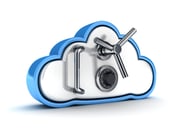Forbes says “…transitioning to the cloud has enabled (companies) to better manage industry disrupti ons, reinvent their business models and fuel massive improvements in the delivery of their services.”
ons, reinvent their business models and fuel massive improvements in the delivery of their services.”
Doesn’t that description sound like the printing industry?
The printing business is transforming. To compete, print service providers must be able to adapt and evolve quickly to meet their client’s needs. Doing business in the cloud gives printers access to the tools and resources necessary to take advantage of new technologies and participate in trends as they develop.
Why the Cloud Works for Printers
Locally hosted platforms can actually keep print companies from responding to customer demands. On-premise systems have limited capacity. To handle more data, offer more options, or improve response, companies must invest in more servers and hire experts to make sure they all connect.
Systems running in the cloud, however, have the advantage of almost unlimited processing power. Printers aren’t required to shop for hardware, wait for delivery, and suffer the agony of reconfiguring a local network to recognize and access the new resources-just to add capacity. In most cases, cloud computing power expands automatically according to demand.
Cloud-based operations have several advantages. Here are a few to consider:
Collaborative Selling – Chances are, your print organization has transitioned from a salesperson-centric sales model to a more consultative approach. We’ve written about the advantages of this strategy many times in our blog. Click Here for a list of relevant articles. In this new arrangement several individuals in your company will consult with clients. With a cloud-based Customer Relationship Management (CRM) system, all parties can view and update customer interactions using a centralized resource. Without such tools, you’ll be relying on internal notes, phone calls, emails, and meetings to keep everyone up to date. When manual recordkeeping is the norm, valuable customer relationship information is lost if a key employee leaves the organization.
Devices – What computers does your company use? It’s probably a mixed bag of Macs, Windows PCs, desktops and laptops. As you know, installing and maintaining software on all those platforms takes lots of time, effort, and money. Cloud-based systems are accessed through a web browser. The computer on which the browser is running is irrelevant because all the programs and the data reside in the cloud. Printers can eliminate many of the headaches that come with multi-vendor computing device maintenance or transition to inexpensive tablet devices like Chromebooks.
Staffing – Looking to add younger people to replace seasoned veterans who retire? (This is a big problem. See our blog post Future Employees.) You must offer new recruits modern tools and computing platforms. Millennials who upgrade their phones every year have little tolerance for old clunky software that lacks features available in the latest releases. Cloud-delivered software stays up to date with the latest versions. Everyone will use the same software and it will be current.
Production Collaboration – Cloud computing allows printing companies to access talent outside their own buildings. Creative people, pre-production staff, management, and customers can all work on projects simultaneously, approve projects, and contribute from anywhere and on any device. Tedious version control, syncing issues, and emailing documents around can be a thing of the past.

What About Security?
One concern printers express about moving processes to the cloud is data security. Companies are afraid their data is vulnerable to theft or snooping after it leaves their building. This is a myth. Large organizations like Amazon Web Services (AWS), that host the most popular cloud computing platforms, have invested millions of dollars in encryption and data security. The big data breaches you hear about on the news didn’t happen on the cloud. Instead, thieves broke into local networks companies believed were secure.
Local networks typically have less protection than their cloud-based counterparts. Accidental breaches, or when computers are lost or stolen, can create problems for print service providers even when they don’t experience a malicious attack. Once you move processing to the cloud, less of your data will reside on local computers where it is most vulnerable.
Floods, fires, hurricanes, and tornadoes can wipe out your building and all the computing equipment, but cloud applications are offsite and automatically backed up. A natural disaster will disrupt your business, but with cloud computing you needn’t worry about losing months or years of business data along with the physical assets.
What to Put in the Cloud
Printers can move many aspects of a typical print operation to the cloud. Here’s a list of applications that might be candidates for migration in your facility:
- Ordering (Web to Print)
- Customer Relationship Management (CRM)
- Marketing Automation (MA)
- File Storage
- File Backup
- Accounting
- Online Conferencing
- Graphic Design
- Proofing
- Postal Processing
As with any business decision, moving work to the cloud requires research and evaluation. Be sure related applications can work together. Many systems use Application Program Interfaces (API’s) to connect systems from multiple vendors. Get technical help to evaluate the choices and set up systems. Then begin moving some operations to the cloud. Once you get used to it, you’ll find the advantages outweigh your concerns.
Gimbel & Associates can help. Arrange for your free consultation. 

